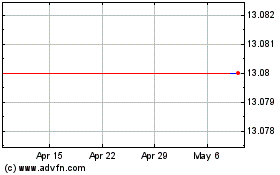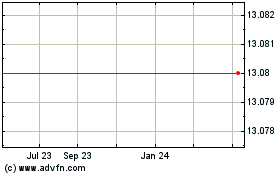Early phase of Sydney's Barangaroo is seen as a success, but
some hurdles remain
By Isobel Lee
This article is being republished as part of our daily
reproduction of WSJ.com articles that also appeared in the U.S.
print edition of The Wall Street Journal (May 2, 2018).
Sydney's controversial Barangaroo project is beginning to shift
the city's commercial center of gravity three years after the first
new tower opened in the city's biggest ever urban-renewal
project.
The first three skyscrapers that have opened, offering 3 million
square feet of office space on the 18.5 acre first phase, have
attracted numerous big-name tenants from traditional business
districts including HSBC Holdings PLC, KPMG Audit PLC,
PricewaterhouseCoopers LLP, Morningstar Inc. and Visa Inc. The
first 159 apartments all sold out within 3 1/2 hours when put on
the market in 2013.
More than 80 restaurants, bars and other attractions also have
transformed the once-abandoned docklands area in central
Sydney.
"The number of people flooding into the spaces that have already
opened is extraordinary," said Chris Wilkinson, architect of the
tallest tower in the 54-acre masterplan, a one billion Australian
dollars (US$758 million) hotel and casino expected to break ground
this year. "It's absolutely full of life."
The success has meant big profits so far for Sydney-based
Lendlease Corporation Ltd., the lead developer of the first A$6
billion phase of the project, named Barangaroo South. In July,
Lendlease began its current fiscal year with A$1 billion in cash
thanks mostly to "urbanization projects, led by commercial at
Barangaroo South," the company's chief financial officer Tarun
Gupta, said on its earnings call in August. "The income from our
more than A$600 million in direct investment in these towers is
expected to increase again in the coming year," he said.
To be sure, it is too early for champagne for the planners and
developers who struggled against community groups trying for years
to limit the commercial development of Barangaroo. Opponents who
have mostly objected to the scale of the project, for example, went
into an uproar over Lendlease's 2015 modifications, which increased
the total building footprint of Barangaroo South from 40% to 46% of
the site in part by adding a Crown hotel and casino in a prime
waterfront location.
"The new designs plunge public spaces into shadow," said John
McInerney, former city of Sydney chief planner, who is part of a
local planning group that unsuccessfully challenged the tower's
location in court.
Moreover, Barangaroo is far from finished. An additional 4.3
million square feet of commercial space eventually will be added to
the 54-acre Barangaroo site by the time the entire project is
completed in 2024.
It is still far from clear whether the new space will be equally
successful in attracting tenants. Especially murky is the future of
the planned casino in Barangaroo's tallest building, a 902-foot
tower -- slated to be developed by Lendlease and operated by
Australian gaming giant Crown Resorts Ltd. -- given the recent
downturn in the number of wealthy Chinese tourists in pursuit of
VIP gaming facilities.
Meanwhile, fights are shaping up between competing developers.
Recently development rights to a 13-acre parcel were awarded to a
venture of construction company Grocon Pty Ltd, Chinese-backed
developer Aqualand Projects Pty Ltd and Scentre Group Ltd.
Many are expecting this venture to try to renegotiate on
building heights following the government's insistence that its
site should include a new metro stop. But this would likely be of
concern to Lendlease and Crown, whose own towers have priceless
sightlines with Sydney Harbour. The Grocon-led consortium declined
to comment.
Still, it is a sign of Barangaroo's commercial success that
developers may be squabbling over who can build higher, observers
say. "This is the last waterfront site in the Sydney (central
business district) available for development. You could say it's
iconic," said Lawson Hubbard of broker CBRE Group Inc., which
represented the majority of the tenants for the first phase of the
project.
Developers have created successful masterplanned projects in
other cities around the world. But it has sometimes taken years for
them to reach critical mass. For example, London's Canary Wharf,
which celebrates its 30th anniversary this year, helped drive its
original developer Olympia & York into bankruptcy protection in
1992.
Hudson Yards, the largest private development in the U.S. now
rising in New York, has learned from those mistakes. That project's
developer, a venture led by Related Cos., has attracted numerous
major tenants from Midtown by timing new office buildings to a new
subway station and residential development.
Barangaroo, too, is banking on getting the commercial,
residential and leisure equation right. The masterplan also
includes the 15-acre Headland Park, a public space built by the New
South Wales government and opened in 2015.
"We worked very hard to curate a really fantastic mix of
restaurants and amenities," said Rob Deck, Lendlease's managing
director for Barangaroo South. "There's everything from barbers and
gelato shops to Japanese tea-houses within 10 minutes of the
offices and residences."
The project's developers are being emboldened by the office
rents the first buildings are attracting, in line with comparable
space in Sydney's traditional business district, where rents just
exceeded A$1,000 per square meter for the first time ever according
to Cushman & Wakefield data.
But that doesn't make opponents feel any better. "That's the
issue. The lion's share of profits from Barangaroo will go to
private hands," said Mr. McInerney. "The government developed the
park, but the costs increased dramatically as it went on. They'll
make some money, but not as much as the developers."
(END) Dow Jones Newswires
May 02, 2018 02:47 ET (06:47 GMT)
Copyright (c) 2018 Dow Jones & Company, Inc.
Crown Resorts (ASX:CWN)
Historical Stock Chart
From Dec 2024 to Jan 2025

Crown Resorts (ASX:CWN)
Historical Stock Chart
From Jan 2024 to Jan 2025
